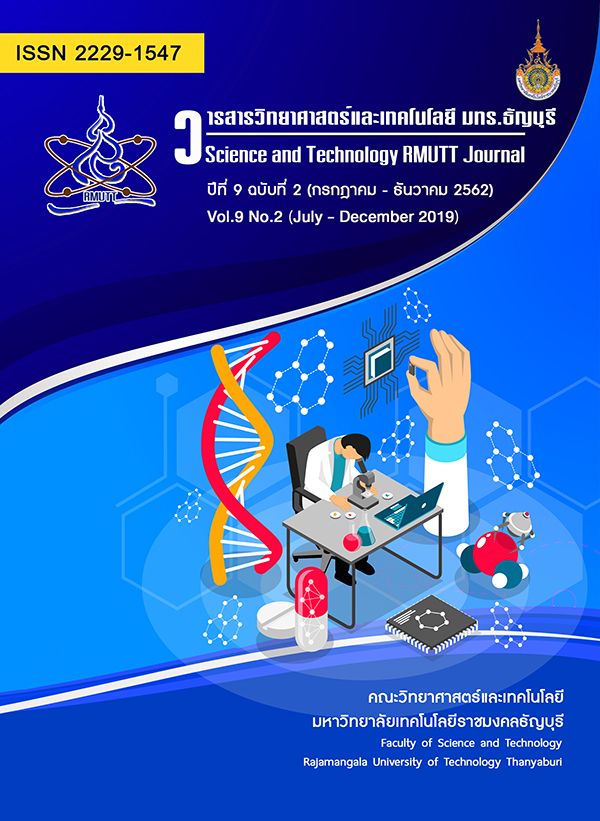Finding a Suitable Threshold Value for an Biometric-Based Authentication System
Main Article Content
Abstract
Authentication is the first line of defense of any information technology systems. One of the popular methods used today is biometric, and iris authentication is gaining popularity. However, the threshold value is deemed to be secure and appropriate has not been thoroughly studied. Threshold is a value that defines the acceptable amount of the correct bits of the image before securely passing the authentication process. Therefore, the main aim of this research was to find a secure and suitable threshold value used in iris authentication system, where iris localization was done by using Circle Hough Transform technique. Iris image databases v.4 from the Chinese Academy of Sciences Institute of Automatic (CASIA) were used in this research. The way to find the appropriate threshold was to test for the right balance of the GAR, FRR and FAR values when trying to verify the person’s identity. The results of the test revealed that the appropriate threshold had the value of 72.9246 percent of all the available bits of the iris image. Both had a high GAR and very low FAR and FRR values. It can be concluded that the obtained threshold value was suitable and secure.
Article Details
References
R. Shay et al., “Encountering Stronger Password Requirements: User Attitudes and Behaviors,” in Proceedings of the Sixth Symposium on Usable Privacy and Security, New York, NY, USA, 2010, p. 2:1–2:20.
L. Leng and J. Zhang, “Dual-key-binding cancelable palmprint cryptosystem for palmprint protection and information security,” J. Netw. Comput. Appl., vol. 34, no. 6, pp. 1979–1989, Nov. 2011.
S. F. Darwaish, E. Moradian, T. Rahmani, and M. Knauer, “Biometric Identification on Android Smartphones,” Procedia Comput. Sci., vol. 35, pp. 832–841, 2014.
S. Garg, A. Kumar, and M. Hanmandlu, “Biometric authentication using finger nail surface,” in 2012 12th International Conference on Intelligent Systems Design and Applications (ISDA), 2012, pp. 497–502.
K. Nandakumar, A. K. Jain, and S. Pankanti, “Fingerprint-Based Fuzzy Vault: Implementation and Performance,” IEEE Trans. Inf. Forensics Secur., vol. 2, no. 4, pp. 744–757, Dec. 2007.
A. Nagar, K. Nandakumar, and A. K. Jain, “A hybrid biometric cryptosystem for securing fingerprint minutiae templates,” Pattern Recognit. Lett., vol. 31, no. 8, pp. 733–741, Jun. 2010.
Z. Jorgensen and T. Yu, “On Mouse Dynamics As a Behavioral Biometric for Authentication,” in Proceedings of the 6th ACM Symposium on Information, Computer and Communications Security, New York, NY, USA, 2011, pp. 476–482.
K. Miyazawa, K. Ito, T. Aoki, K. Kobayashi, and H. Nakajima, “An Effective Approach for Iris Recognition Using Phase-Based Image Matching,” IEEE Trans. Pattern Anal. Mach. Intell., vol. 30, no. 10, pp. 1741–1756, Oct. 2008.
Verma, P., Dubey, M., Basu, S., & Verma, P., “Hough transform method for iris recognition: A biometric approach,” Int J Eng Inn Technol, vol. 1, pp. 43–48.
F. Jan, I. Usman, and S. Agha, “Reliable iris localization using Hough transform, histogram-bisection, and eccentricity,” Signal Process., vol. 93, no. 1, pp. 230–241, Jan. 2013.
F. Jan, I. Usman, S. A. Khan, and S. A. Malik, “Iris localization based on the Hough transform, a radial-gradient operator, and the gray-level intensity,” Opt. - Int. J. Light Electron Opt., vol. 124, no. 23, pp. 5976–5985, Dec. 2013.
P. K. Pallav and S. R. Ganorkar, Investigation and Analysis of Hough-DCT- Hamming Distance Based Method of Iris Recognition. .
T.-H. Min and R.-H. Park, “Eyelid and eyelash detection method in the normalized iris image using the parabolic Hough model and Otsu’s thresholding method,” Pattern Recognit. Lett., vol. 30, no. 12, pp. 1138–1143, Sep. 2009.
J. Illingworth and J. Kittler, “A survey of the hough transform,” Comput. Vis. Graph. Image Process., vol. 44, no. 1, pp. 87–116, Oct. 1988.
“Biometrics ideal test/CASIA Iris Image Database Version 4.0,” 23-Oct-2016.
New Methods in Iris Recognition. .
E. Mohammadi Arvacheh, “A Study of Segmentation and Normalization for Iris Recognition Systems,” 2006.
J. Daugman, “How iris recognition works,” IEEE Trans. Circuits Syst. Video Technol., vol. 14, no. 1, pp. 21–30, Jan. 2004.
A. Bouridane, “Recent Advances in Iris Recognition: A Multiscale Approach,” in Imaging for Forensics and Security, Springer US, 2009, pp. 49–77.
“Iris Recognition: On the Segmentation of Degraded Images Acquired in the Visible Wavelength - Semantic Scholar.” [Online]. Available: /paper/Iris-Recognition-On-the-Segmentation-of-Degraded-Proença/ a3fcf3d32a5a4fcc83 027e3d367ecc0df3ec4f64. [Accessed: 06-Feb-2017].
N. Cherabit, F. Z. Chelali, A. Djeradi, N. Cherabit, F. Z. Chelali, and A. Djeradi, “Circular Hough Transform for Iris localization,” Sci. Technol., vol. 2, no. 5, pp. 114–121, 2012.
Y. Desmedt, “Threshold cryptosystems,” in Advances in Cryptology — AUSCRYPT ’92, 1992, pp. 1–14.
L. Birgale and M. Kokare, Iris Recognition Without Iris Normalization 1. .
H. Proenca and L. A. Alexandre, “Iris Recognition: An Analysis of the Aliasing Problem in the Iris Normalization Stage,” in 2006 International Conference on Computational Intelligence and Security, 2006, vol. 2, pp. 1771–1774.
M. Vatsa, R. Singh, and A. Noore, “Improving Iris Recognition Performance Using Segmentation, Quality Enhancement, Match Score Fusion, and Indexing,” IEEE Trans. Syst. Man Cybern. Part B Cybern., vol. 38, no. 4, pp. 1021–1035, Aug. 2008.
T. Tan, Z. He, and Z. Sun, “Efficient and robust segmentation of noisy iris images for non-cooperative iris recognition,” Image Vis. Comput., vol. 28, no. 2, pp. 223–230, Feb. 2010.
M. T. Khan, D. Arora, and S. Shukla, “Feature extraction through iris images using 1-D Gabor filter on different iris datasets,” in 2013 Sixth International Conference on Contemporary Computing (IC3), 2013, pp. 445–450.


